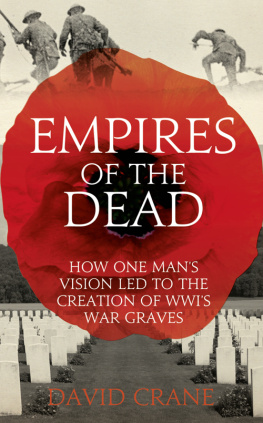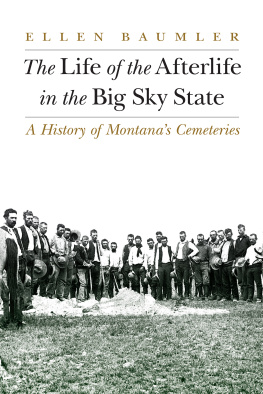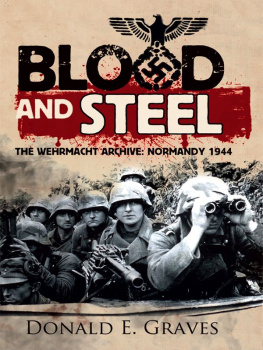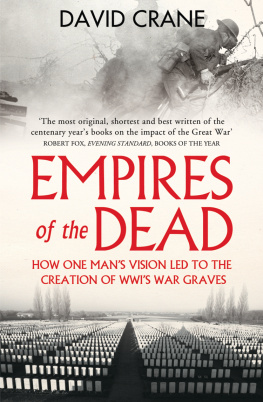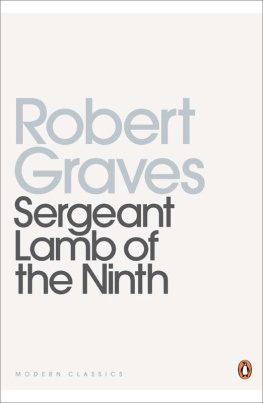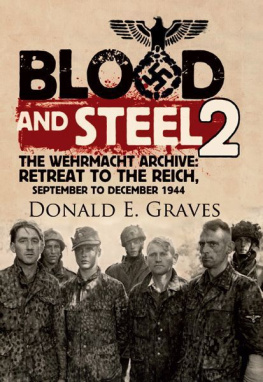CONTENTS
Australia
HarperCollins Publishers (Australia) Pty. Ltd.
Level 13, 201 Elizabeth Street
Sydney, NSW 2000, Australia
http://www.harpercollins.com.au/ebooks
Canada
HarperCollins Canada
2 Bloor Street East - 20th Floor
Toronto, ON, M4W, 1A8, Canada
http://www.harpercollins.ca
New Zealand
HarperCollins Publishers (New Zealand) Limited
P.O. Box 1
Auckland, New Zealand
http://www.harpercollins.co.nz
United Kingdom
HarperCollins Publishers Ltd.
77-85 Fulham Palace Road
London, W6 8JB, UK
http://www.harpercollins.co.uk
United States
HarperCollins Publishers Inc.
10 East 53rd Street
New York, NY 10022
http://www.harpercollins.com
There is an immense and growing literature on every aspect of the First World War and a very distinguished one on the subject of commemoration and remembrance addressed here. The first debt of anyone writing about the Imperial War Graves Commission will always be to its original historian Philip Longworth, but I hope that the most cursory glance at the bibliography and endnotes of this book will show how much it owes to the writers who have shaped the way we see our military cemeteries and memorials. Nobody, for instance, should visit Lutyenss great memorial at Thiepval without taking along Gavin Stamps brilliant The Memorial to the Missing of the Somme.
I would like to thank all those friends and family who were prepared to talk about this book, read it in manuscript, provide photographs and visit the cemeteries with me, and in particular the Schrck family for their kindness and hospitality while I was looking at German war graves in Pforzheim. My thanks, too, to the Canadian volunteers at Vimy Ridge and the Newfoundland Memorial and Park at Beaumont-Hamel, who could not have been more helpful, and to Susanna Kerr for allowing me to quote from unpublished family material. I am grateful to everyone at William Collins who has worked on this book, but especially to Arabella Pike and Essie Cousins who suggested it in the first place, and to Kate Tolley. I have been greatly helped by the sympathetic and perceptive editing of Kate Johnson. My thanks, also, to Derek Johns.
Above all, this book would not have been possible without the kindness, patience and expertise of Roy Hemington at the Commonwealth War Graves Commission at Maidenhead. The Commission holds a vast archive covering the foundation and history of the Imperial War Graves Commission, and I could not even have begun to negotiate it without his help in answering my endless questions. I am very grateful to him and to the Commission for allowing me unstinted access to their archive, and to Peter Francis for his generous help in the latter stages of the book. I would also like to thank the Warden and Scholars of New College, Oxford, for kind permission to quote from the papers of Viscount Milner. This book, as always, is for Honor.
Men of War: The Changing Face of Heroism in the 19th Century Navy
Scott of the Antarctic: A Life of Courage and Tragedy in the Extreme South
The Kindness of Sisters: Annabella Milbanke and the Destruction of the Byrons
Lord Byrons Jackal: A Life of Trelawny
Archives
The main source for this book is the archive of the Commonwealth War Graves Commission (CWGC) at Maidenhead. The other major archives used are the National Archives at Kew, and the Milner Papers in the Bodleian Library, Oxford
Primary and Secondary Sources
Aslet, C., War Memorial: The Story of One Villages Sacrifice from 1914 to 2003, London, 2012
Baker, H., Architecture and Personalities, London, 1944
Beveridge, Lord, Power and Influence, London, 1953
Birkenhead, Lord, Rudyard Kipling, New York, 1978
Blomfield, R., Memoirs of an Architect, London, 1932
Blunden, E., Undertones of War, London, 1928
Blythe, R., The Age of Illusion, London, 1963
Brittain, V., Testament of Youth, London, 1933
Carrington, C., Rudyard Kipling: His Life and Work, London, 1955
Earle, L., Turn Over the Page, London, 1935
Fussell, P., The Great War and Modern Memory, Oxford, 1975
Garfield, J., The Fallen, Stroud, 2008
Gibson, E., and Ward, J. K., Courage Remembered: The Story Behind the Construction and Maintenance of the Commonwealths Military Cemeteries and Memorials of the Wars of 19141918 and 19391945, London, 1989
Gladstone, Viscount, W. G. C. Gladstone: A Memoir, London, 1918
Gollin, A. M., Proconsul in Politics: A Study of Lord Milner in Opposition and in Power, London, 1964
Holmes, R., Tommy: The British Soldier on the Western Front 19141918, London, 2004
Shots from the Front: The British Soldier 19141918, London, 2008
Hurst, S., The Silent Cities, London, 1929
Hussey, C., The Life of Sir Edwin Lutyens, London, 1950
Inglis, K. S., and Brazier, J., Sacred Places: War Memorials in the Australian Landscape, Melbourne, 1998
Janes, B., The Unknown Warrior and the Cavell Van, Tenterden, no date
Karol, E., Charles Holden Architect 18751960, Donington, 2007
Kenyon, F., War Graves: How the Cemeteries Abroad Will Be Designed, HMSO, London, 1918
Linenthal, E. T., Sacred Ground: Americans and Their Battlefields, Chicago, 1991
Longworth, P., The Unending Vigil, London, 1967
Macready, N., Annals of an Active Life, London, 1924
Masefield, J., The Old Front Line, London, 1917
Nimocks, W., Milners Young Men: The Kindergarten in Edwardian Imperial Affairs, London, 1970
Percy, C., and Ridley, J., eds., The Letters of Edwin Lutyens to his Wife Lady Emily, London, 1985
Quinlan, M., British War Memorials, Hertford, 2005.
Remarque, E. M., All Quiet on the Western Front, translated by B. Murdoch, London, 1996
Sassoon, S., The Complete Memoirs of George Sherston, London, 1937
Stamp, G., The Memorial to the Missing of the Somme, London, 2007
Stevenson, D., 19141918: The History of the First World War, London, 2004
With Our Backs to the Wall: Victory and Defeat in 1918, London, 2011
Strachan, H., The First World War, London, 2003
Summers, J., Remembered: The History of the Commonwealth War Graves Commission, London, 2007
Vaughan, E., Some Desperate Glory, London, 1917
Ware, F., Educational Reform, London, 1900
Educational Foundations of Trade and Industry, London, 1901
The Worker and His Country, London, 1912
The Immortal Heritage: An Account of the Work and Policy of the Imperial War Graves Commission during Twenty Years, 19171937, London, 1937
Wilson, K. M., A Study in the History and Politics of the Morning Post 19051926, Lampeter, 1990
Winter, D., Deaths Men, London, 1978
Winter, J., Sites of Memory, Sites of Mourning: The Great War in European Cultural History, Cambridge, 1996
Who has matched us with His hour,
RUPERT BROOKE
On the afternoon of Saturday 19 September 1914, a spare, dark-haired man in his mid-forties arrived at Lille in northern France to take command of the motley collection of vehicles and drivers that made up the British Red Crosss flying unit. For the past four years he had been largely out of the public eye, but if there were few in the unit who would have recognised the face, they would undoubtedly have known the name of the man who for five turbulent years had been the erratically brilliant, warmongering editor of the right-wing, imperialist
Next page
